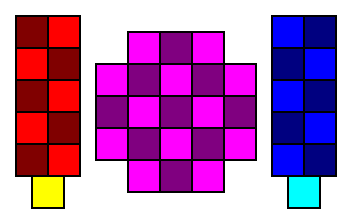Chestria
By Jared B. McComb
IntroductionChestria is played on the board shown at right, between two players, Red and Blue. Each player has their own private board, which is their color, and there is a Battlefield in between them, which is purple. Each private board has ten Setup spaces and one Special space. The Battlefield has twenty-one spaces in it. There are a total of forty-three spaces. |

|
Rules
- At the start of the game there are no pieces on the board.
Pieces are determined randomly (see Setup, below).
- Red goes first. On Red's first turn, they must place a
Fodder piece on any space on the board.
- A piece on your private board may be played to any vacant
space on the Battlefield as a turn. When a piece is played
on the Battlefield, any piece which it attacks, and which does
not counter-attack it at the same time, is flipped to the
attacker's color. Multiple pieces may be attacked and flipped
at one time. However, the newly flipped pieces do not
flip other pieces in turn.
- Pieces can only move from the private boards to the
Battlefield, and never move once they are on the Battlefield.
- The pieces on the Special space may be played to a space
containing a friendly piece, in which it takes the place of
that piece and attacks other pieces as normal. They may be
used at any time, but they must be used during the course of
the game; if you do not use yours in the middle of the game,
you must use it as your last turn.
- The player with the most pieces on the battlefield at the end wins.
Setup and Pieces
Roll a 20-sided die, check the chart, and put the appropriate piece on your private board. Repeat eleven times for each player. The eleventh roll becomes your special move.| Roll | Piece |
| 1 | Ferz |
| 2 | Alfil |
| 3 | Bishop |
| 4 | Wazir |
| 5 | Dababbah |
| 6 | Rook |
| 7 | King |
| 8 | Alibaba |
| 9 | Queen |
| 10 | Crab |
| 11 | Barc |
| 12 | Wide Knight (moves along widest of the Knight moves) |
| 13 | Narrow Knight (moves along narrowest of the Knight moves) |
| 14 | Knight |
| 15 | Silver |
| 16 | Reverse Silver (diagonally or orthogonally backwards) |
| 17 | Gold |
| 18 | Reverse Gold (orthogonally or diagonally backwards) |
| 19 | Marshall |
| 20 | Cardinal |
The Fodder piece has no attacking powers whatsoever. All other pieces attack any squares they could move to if this were a game with movement. Note that both players have the same notion of forwardness and backwardness.
Variant
Instead of having both players roll for their pieces separately, have each roll count for both players so that each player has an army identical to the other.Computer Play
Shh!Do you hear that?
It's this game, screaming ?ZRFolize me! ZRFolize me! I wanna be ZRFolized! I wanna be played on a computer! PLEEEEEASE!!!?
Credits
This game was inspired mainly by the fabulous collectible card minigame, Triple Triad, from the otherwise mediocre role-playing game, Final Fantasy VIII. Special thanks go to some guy who calls himself Qhimm for making the uber-awesome Triple Triad Gold (found at http://ttg.qhimm.com) so I could play Triple Triad on my PC.The original Triple Triad was designed by Hiroyuki Yotsuji, programmed by Kentarow Yasui, and produced by Takayoshi Nakazato, and is copyright Squaresoft, Inc. www.squaresoft.com.
Written by Jared B. McComb. HTML Conversion by Peter Aronson.
WWW page created: April 14th, 2003.